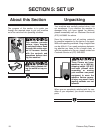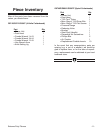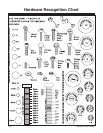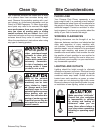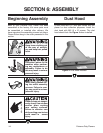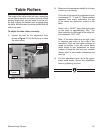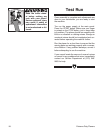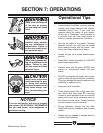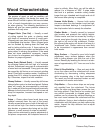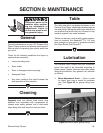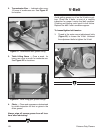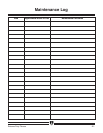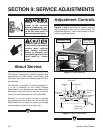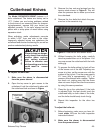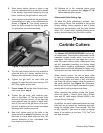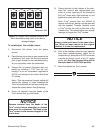
-18- Extreme Duty Planers
snipe is unlikely. More likely, you will be able to
reduce it to a tolerance of .002". If snipe under
that level is a problem, consider cutting lumber
longer that your intended work length and cut off
the excess after planing is completed.
Uneven Knife Marks — Uneven knife marks
can occur when the chip breaker is set too high.
Inspect cutterhead bearings if re-adjustment of
the chip breaker fails to remedy the situation.
Chatter Marks — Usually caused by incorrect
chip breaker and pressure bar setting heights.
Chatter marks can also be caused by running a
narrow wood piece through the planer at either
the right or left end of the cutterhead. Chatter,
like uneven knife marks, will show in the form of a
“washboard” look. Chatter marks are more likely
to be inconsistent in appearance than uneven
knife marks.
Wavy Surface — Caused by poor knife height
adjustment, wavy surface appears when one
knife is taking deeper cuts than the rest of the
knives. Remedy by resetting the knives to a toler
-
ance of approximately .001" from one end to the
other.
Pitch & Glue Build-Up — Glue and resin build-
up on the rollers and the cutterhead will cause
overheating by decreasing cutting sharpness
while increasing drag in the feed mechanism.
The result can include scorched lumber as well
as uneven knife marks and chatter.
Chip Marks — Occur when chips are not prop
-
erly expelled from the cutterhead. The knives
catch the chips and drag them across the lum
-
ber being planed. Chips tend to be random and
non-uniform (compared to chipped grain). This
problem can be caused by exhaust blockage or
too much room between the cutterhead and the
chip deflector. Using a dust collection system in
combination with the planer can help reduce chip
marks. Inspect the chip deflector and re-adjust
spring tension.
Wood Characteristics
The species of wood, as well as condition, will
affect planing ability—the harder the wood, the
more difficult it will be to plane. We have included
a list of wood characteristics you may encoun
-
ter when planing, The following descriptions of
defects will give you some possible answers to
problems that may arise.
Chipped Grain (Tear Out) — Usually a result
of cutting against the grain, or planing wood
with knots or excessive amount of cross grain.
Chipped grain can also be caused by dull knives
or misaligned chip breaker. Often, chipped grain
can be avoided by slowing down the feed rate
and by taking shallow cuts, If those options do
not work, inspect your lumber and determine if its
grain pattern is causing the problem. If the wood
does not show substantial crossgrain, inspect
your knives for sharpness and inspect the chip
breaker for proper alignment.
Fuzzy Grain (Raised Grain) — Usually caused
by surfacing lumber with too high of a moisture
content. Sometimes fuzzy grain is a characteristic
of wood such as basswood. Fuzzy grain can also
be caused by dull knives or an incorrect grinding
bevel. Check with a moisture meter. If moisture is
greater than 20%, sticker the wood and allow it to
dry. Otherwise, inspect the knife condition.
Glossy Surface — Usually caused by dull knives
taking shallow cuts at a slow feed speed. Surface
gloss will usually be accompanied by overheat
-
ing. Lumber will often be scorched and eventually
damage to the knives will occur. If the knives are
sharp on inspection, increase feed speed or cut
-
ting depth.
Snipe — Occurs when board ends have more
material removed them the rest of the board.
Usually caused when one or both of the table roll
-
ers are set too high. Can also be caused by the
chip breaker or pressure bar being set too high.
However, a small amount of snipe is inevitable.
Snipe can be minimized by proper adjustment of
the planer components, but complete removal of



